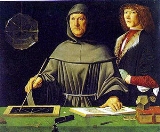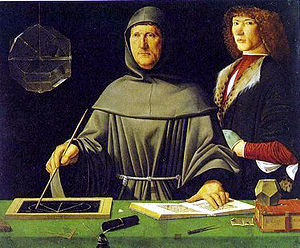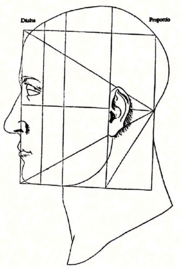
Luca Pacioli
Encyclopedia

Italy
Italy , officially the Italian Republic languages]] under the European Charter for Regional or Minority Languages. In each of these, Italy's official name is as follows:;;;;;;;;), is a unitary parliamentary republic in South-Central Europe. To the north it borders France, Switzerland, Austria and...
mathematician
Mathematician
A mathematician is a person whose primary area of study is the field of mathematics. Mathematicians are concerned with quantity, structure, space, and change....
, Franciscan
Franciscan
Most Franciscans are members of Roman Catholic religious orders founded by Saint Francis of Assisi. Besides Roman Catholic communities, there are also Old Catholic, Anglican, Lutheran, ecumenical and Non-denominational Franciscan communities....
friar, collaborator with Leonardo da Vinci
Leonardo da Vinci
Leonardo di ser Piero da Vinci was an Italian Renaissance polymath: painter, sculptor, architect, musician, scientist, mathematician, engineer, inventor, anatomist, geologist, cartographer, botanist and writer whose genius, perhaps more than that of any other figure, epitomized the Renaissance...
, and seminal contributor to the field now known as accounting. He was also called Luca di Borgo after his birthplace, Borgo Sansepolcro
Sansepolcro
Sansepolcro , is a town and comune in Tuscany, Italy, in the province of Arezzo.Situated on the upper reaches of the Tiber river, Borgo was the birthplace of the painters Piero della Francesca, Raffaellino del Colle and Angiolo Tricca...
, Tuscany
Tuscany
Tuscany is a region in Italy. It has an area of about 23,000 square kilometres and a population of about 3.75 million inhabitants. The regional capital is Florence ....
.
Life
Luca Pacioli was born in 1447 in SansepolcroSansepolcro
Sansepolcro , is a town and comune in Tuscany, Italy, in the province of Arezzo.Situated on the upper reaches of the Tiber river, Borgo was the birthplace of the painters Piero della Francesca, Raffaellino del Colle and Angiolo Tricca...
(Tuscany) where he received an abbaco education. This was education in the vernacular (i.e. the local tongue) rather than Latin and focused on the knowledge required of merchants. He moved to Venice around 1464, where he continued his own education while working as a tutor to the three sons of a merchant. It was during this period that he wrote his first book, a treatise on arithmetic for the boys he was tutoring. Between 1472 and 1475, he became a Franciscan
Franciscan
Most Franciscans are members of Roman Catholic religious orders founded by Saint Francis of Assisi. Besides Roman Catholic communities, there are also Old Catholic, Anglican, Lutheran, ecumenical and Non-denominational Franciscan communities....
friar.
In 1475, he started teaching in Perugia, first as a private teacher, from 1477 holding the first chair in mathematics. He wrote a comprehensive textbook in the vernacular for his students. He continued to work as a private tutor of mathematics
Mathematics
Mathematics is the study of quantity, space, structure, and change. Mathematicians seek out patterns and formulate new conjectures. Mathematicians resolve the truth or falsity of conjectures by mathematical proofs, which are arguments sufficient to convince other mathematicians of their validity...
and was, in fact, instructed to stop teaching at this level in Sansepolcro in 1491. In 1494, his first book to be printed, Summa de arithmetica, geometria, proportioni et proportionalità, was published in Venice. In 1497, he accepted an invitation from duke Ludovico Sforza
Ludovico Sforza
Ludovico Sforza , was Duke of Milan from 1489 until his death. A member of the Sforza family, he was the fourth son of Francesco Sforza. He was famed as a patron of Leonardo da Vinci and other artists, and presided over the final and most productive stage of the Milanese Renaissance...
to work in Milan
Milan
Milan is the second-largest city in Italy and the capital city of the region of Lombardy and of the province of Milan. The city proper has a population of about 1.3 million, while its urban area, roughly coinciding with its administrative province and the bordering Province of Monza and Brianza ,...
. There he met, collaborated with, lived with, and taught mathematics to Leonardo da Vinci
Leonardo da Vinci
Leonardo di ser Piero da Vinci was an Italian Renaissance polymath: painter, sculptor, architect, musician, scientist, mathematician, engineer, inventor, anatomist, geologist, cartographer, botanist and writer whose genius, perhaps more than that of any other figure, epitomized the Renaissance...
. In 1499, Pacioli and Leonardo were forced to flee Milan when Louis XII of France
Louis XII of France
Louis proved to be a popular king. At the end of his reign the crown deficit was no greater than it had been when he succeeded Charles VIII in 1498, despite several expensive military campaigns in Italy. His fiscal reforms of 1504 and 1508 tightened and improved procedures for the collection of taxes...
seized the city and drove out their patron. Their paths appear to have finally separated around 1506. Pacioli died at age 70 in 1517, most likely in Sansepolcro where it is thought that he had spent much of his final years.
Mathematics


Mathematics
Mathematics is the study of quantity, space, structure, and change. Mathematicians seek out patterns and formulate new conjectures. Mathematicians resolve the truth or falsity of conjectures by mathematical proofs, which are arguments sufficient to convince other mathematicians of their validity...
, including:
- Tractatus mathematicus ad discipulos perusinos (Ms. Vatican Library, Lat. 3129), a textbook of almost 600 pages, dedicated to his students at the University of Perugia where Pacioli was teaching from 1477 to 1480. The manuscript was written between December 1477 and completed on 29 April 1478. It contains 16 sections on merchant arithmetic, such as barter, exchange, profit, mixing metals, and algebra. One part of 25 pages is missing from the chapter on algebra. A modern transcription has been published by Calzoni and Cavazzoni (1996) as well as a partial translation of the chapter on partitioning problems (Heeffer, 2010).
- Summa de arithmetica, geometria, proportioni et proportionalità (VeniceVeniceVenice is a city in northern Italy which is renowned for the beauty of its setting, its architecture and its artworks. It is the capital of the Veneto region...
1494), a textbook for use in the schools of Northern Italy. It was a synthesis of the mathematical knowledge of his time and contained the first printed work on algebra written in the vernacular (i.e. the spoken language of the day). It is also notable for including the first published description of the method of bookkeeping that Venetian merchants used during the Italian Renaissance, known as the double-entry accounting system.The system he published included most of the accounting cycle as we know it today. He described the use of journals and ledgers, and warned that a person should not go to sleep at night until the debits equalled the credits. His ledger had accounts for assets (including receivables and inventories), liabilities, capital, income, and expenses — the account categories that are reported on an organization's balance sheetBalance sheetIn financial accounting, a balance sheet or statement of financial position is a summary of the financial balances of a sole proprietorship, a business partnership or a company. Assets, liabilities and ownership equity are listed as of a specific date, such as the end of its financial year. A...
and income statementIncome statementIncome statement is a company's financial statement that indicates how the revenue Income statement (also referred to as profit and loss statement (P&L), statement of financial performance, earnings statement, operating statement or statement of operations) is a company's financial statement that...
, respectively. He demonstrated year-end closing entries and proposed that a trial balanceTrial balanceA trial balance is a list of all the nominal ledger accounts contained in the ledger of a business. This list will contain the name of the nominal ledger account and the value of that nominal ledger account. The value of the nominal ledger will hold either a debit balance value or a credit value...
be used to prove a balanced ledger. Also, his treatise touches on a wide range of related topics from accounting ethicsAccounting ethicsAccounting ethics is primarily a field of applied ethics, the study of moral values and judgments as they apply to accountancy. It is an example of professional ethics. Accounting ethics were first introduced by Luca Pacioli, and later expanded by government groups, professional organizations, and...
to cost accountingCost accountingCost accounting information is designed for managers. Since managers are taking decisions only for their own organization, there is no need for the information to be comparable to similar information from other organizations...
. Remarkably, in the solution for one problem he presented in the book he used an approximation of 100*log 2, more than 100 years before Napier and Briggs. - De viribus quantitatis (Ms. Università degli Studi di Bologna, 1496–1508), a treatise on mathematics and magic. Written between 1496 and 1508 it contains the first reference to card tricks as well as guidance on how to juggle, eat fire and make coins dance. It is the first work to note that Leonardo was left-handed. De viribus quantitatis is divided into three sections: mathematical problems, puzzles and tricks, and a collection of proverbs and verses. The book has been described as the "foundation of modern magic and numerical puzzles", but it was never published and sat in the archives of the University of Bologna, seen only by a small number of scholars since the Middle Ages. The book was rediscovered after David SingmasterDavid SingmasterDavid Breyer Singmaster is a retired professor of mathematics at London South Bank University, England, UK. A self-described metagrobologist, he is most famous for his solution to the Rubik's cube and his huge personal collection of mechanical puzzles and books of brain teasers. He is also...
, a mathematician, came across a reference to it in a 19th-century manuscript. An English translation was published for the first time in 2007. - Geometry (1509), a Latin translation of EuclidEuclidEuclid , fl. 300 BC, also known as Euclid of Alexandria, was a Greek mathematician, often referred to as the "Father of Geometry". He was active in Alexandria during the reign of Ptolemy I...
's ElementsEuclid's ElementsEuclid's Elements is a mathematical and geometric treatise consisting of 13 books written by the Greek mathematician Euclid in Alexandria c. 300 BC. It is a collection of definitions, postulates , propositions , and mathematical proofs of the propositions...
. - De divina proportioneDe divina proportioneDe Divina Proportione is a famous book on mathematics written by Luca Pacioli around 1497 in Milan. Today only two versions of the original manuscript are believed still to exist...
(written in Milan in 1496–98, published in Venice in 1509). Two versions of the original manuscript are extant, one in the Biblioteca Ambrosiana in Milan, the other in the Bibliothèque Publique et Universitaire in Geneva. The subject was mathematical and artistic proportion, especially the mathematics of the golden ratioGolden ratioIn mathematics and the arts, two quantities are in the golden ratio if the ratio of the sum of the quantities to the larger quantity is equal to the ratio of the larger quantity to the smaller one. The golden ratio is an irrational mathematical constant, approximately 1.61803398874989...
and its application in architectureArchitectureArchitecture is both the process and product of planning, designing and construction. Architectural works, in the material form of buildings, are often perceived as cultural and political symbols and as works of art...
. Leonardo da VinciLeonardo da VinciLeonardo di ser Piero da Vinci was an Italian Renaissance polymath: painter, sculptor, architect, musician, scientist, mathematician, engineer, inventor, anatomist, geologist, cartographer, botanist and writer whose genius, perhaps more than that of any other figure, epitomized the Renaissance...
drew the illustrations of the regular solids in De divina proportione while he lived with and took mathematics lessons from Pacioli. Leonardo's drawings are probably the first illustrations of skeletonic solids, which allowed an easy distinction between front and back. The work also discusses the use of perspective by painters such as Piero della FrancescaPiero della FrancescaPiero della Francesca was a painter of the Early Renaissance. As testified by Giorgio Vasari in his Lives of the Artists, to contemporaries he was also known as a mathematician and geometer. Nowadays Piero della Francesca is chiefly appreciated for his art. His painting was characterized by its...
, Melozzo da ForlìMelozzo da ForlìMelozzo da Forlì was an Italian Renaissance painter and architect. His fresco paintings are notable for the use of foreshortening. He was the most important member of the Forlì painting school.- Biography :...
, and Marco PalmezzanoMarco PalmezzanoMarco Palmezzano was an Italian painter and architect, belonging to the Forlì painting school, who painted in a style recalling earlier Northern Renaissance models, and was mostly active near Forlì.-Biography:...
. As a side note, the "M" logo used by the Metropolitan Museum of ArtMetropolitan Museum of ArtThe Metropolitan Museum of Art is a renowned art museum in New York City. Its permanent collection contains more than two million works, divided into nineteen curatorial departments. The main building, located on the eastern edge of Central Park along Manhattan's Museum Mile, is one of the...
in New York City is taken from De divina proportione.
Translation of Piero della Francesca's work
The majority of the second volume of Summa de arithmetica, geometria, proportioni et proportionalità was a slightly rewritten version of one of Piero della FrancescaPiero della Francesca
Piero della Francesca was a painter of the Early Renaissance. As testified by Giorgio Vasari in his Lives of the Artists, to contemporaries he was also known as a mathematician and geometer. Nowadays Piero della Francesca is chiefly appreciated for his art. His painting was characterized by its...
's works. The third volume of Pacioli's De divina proportione was an Italian translation of Piero della Francesca
Piero della Francesca
Piero della Francesca was a painter of the Early Renaissance. As testified by Giorgio Vasari in his Lives of the Artists, to contemporaries he was also known as a mathematician and geometer. Nowadays Piero della Francesca is chiefly appreciated for his art. His painting was characterized by its...
's Latin writings On [the] Five Regular Solids. In neither case, did Pacioli include an attribution to Piero. He was severely criticized for this and accused of plagiarism by sixteenth-century art historian and biographer Giorgio Vasari
Giorgio Vasari
Giorgio Vasari was an Italian painter, writer, historian, and architect, who is famous today for his biographies of Italian artists, considered the ideological foundation of art-historical writing.-Biography:...
. R. Emmett Taylor (1889–1956) said that Pacioli may have had nothing to do with the translated volume De divina proportione, and that it may just have been appended to his work. However, no such defence can be presented concerning the inclusion of Piero della Francesca's material in Pacioli's Summa.
Chess
Pacioli also wrote an unpublished treatise on chessChess
Chess is a two-player board game played on a chessboard, a square-checkered board with 64 squares arranged in an eight-by-eight grid. It is one of the world's most popular games, played by millions of people worldwide at home, in clubs, online, by correspondence, and in tournaments.Each player...
, De ludo scacchorum
De ludo scacchorum
De ludo scacchorum or De ludo scachorum , also known as Schifanoia , is a manuscript on the game of chess written around 1500 by Luca Pacioli, a leading mathematician of the Renaissance...
(On the Game of Chess). Long thought to have been lost, a surviving manuscript
Manuscript
A manuscript or handwrite is written information that has been manually created by someone or some people, such as a hand-written letter, as opposed to being printed or reproduced some other way...
was rediscovered in 2006, in the 22,000-volume library of Count Guglielmo Coronini. A facsimile edition of the book was published in Pacioli's home town of Sansepolcro in 2008. Based on Leonardo da Vinci's long association with the author and his having illustrated De divina proportione, some scholars speculate that Leonardo either drew the chess problem
Chess problem
A chess problem, also called a chess composition, is a puzzle set by somebody using chess pieces on a chess board, that presents the solver with a particular task to be achieved. For instance, a position might be given with the instruction that White is to move first, and checkmate Black in two...
s that appear in the manuscript or at least designed the chess pieces used in the problems.
See also
- List of Roman Catholic scientist-clerics
- Della mercatura e del mercante perfettoDella mercatura e del mercante perfettoDella mercatura e del mercante perfetto written by Benedikt Kotruljević around 1400 was the first bookkeeping manuscript and trade manual. It also goes by the names Of commerce and the perfect merchant, On merchantry and the perfect merchant and On trade and the perfect dealer.- History :Several...
Sources
- Calzoni, Giuseppe and Gianfranco Cavazzoni (eds.) (1996) Tractatus Mathematicus ad Discipulos Perusinos, Citta di Castello, Perugia.
- Heeffer, Albrecht, "Algebraic partitioning problems from Luca Paccioli’s Perugia manuscript (Vat. Lat. 3129)" in Sources and Commentaries in Exact Sciences, (2010), 11, pp. 3–52
- Pacioli, Luca. De divina proportione (English: On the Divine Proportion), Luca Paganinem de Paganinus de Brescia (Antonio Capella) 1509, Venice
- Taylor, Emmet, R. No Royal Road: Luca Paccioli and his Times (1942)
- Full Biography of Pacioli (St.Andrews)
- Lucas Paccioli - Catholic EncyclopediaCatholic EncyclopediaThe Catholic Encyclopedia, also referred to as the Old Catholic Encyclopedia and the Original Catholic Encyclopedia, is an English-language encyclopedia published in the United States. The first volume appeared in March 1907 and the last three volumes appeared in 1912, followed by a master index...
article - Libellus de quinque corporibus regularibus, corredato della versione volgare di Luca Paccioli [facsimile del Codice Vat. Urb. Lat. 632]; eds. Cecil Grayson,... Marisa Dalai Emiliani, Carlo Maccagni. Firenze, Giunti, 1995. 3 vol. (68 ff., XLIV-213, XXII-223 pp.). ISBN 88-09-01020-5

